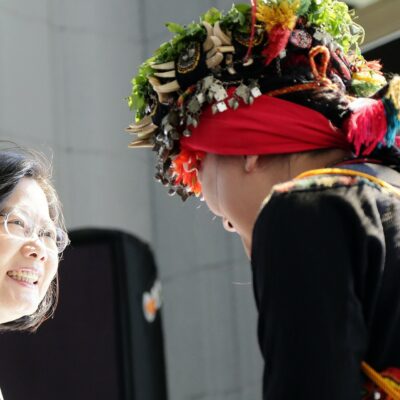Since the outbreak of the COVID-19 pandemic, there’s been a great deal of evidence showing a surge of Sinophobia and anti-Asian racism in Australia.
This wave of racism is concerning and alarming but not surprising or novel, given the discrimination faced by Chinese immigrants during the Gold Rush in the mid and late-19th century, Asian immigrants in the early and mid-20th century, and Muslim immigrants in the post 9/11 era, among others.
The recurrence of anti-immigrant racism in Australia suggests that its root cause remains, and more systematic diagnosis is needed.
COVID-19 and the revival of anti-Chinese and anti-Asian racism
The outbreak of COVID-19 has caused a surge of Sinophobia and anti-Asian racism in Australia and elsewhere.
Nearly 60 percent of the Chinese Australians and Asian-born population surveyed in a major new report by the Scanlon Foundation suggested that during the COVID-19 pandemic, racism was a ‘very big’ or ‘fairly big’ problem. In a recent study of more than 3,000 people, researchers from the Australian National University suggest that nearly 85 percent of Asian Australians reported experiences of racism during the pandemic. This is despite the fact that, in April 2020 (approximately three months after the first COVID-19 case was detected in Australia), only a tiny percentage of cases in Australia (0.35 percent) were directly from mainland China—the overwhelming proportion were from Europe and the Americas. As stated by the convenor of the Asian Australian Alliance, Thomson Ch’ng, ‘COVID-19 has no doubt amplified what has long been toxic in Australian society—racism and racial discrimination’.
Sections of the Australian media have exacerbated the situation, and some have played a disgraceful role in fueling racism against Asian immigrants, particularly Chinese. According to an analysis of media coverage, Chinese have been the target of the highest percentage of racist opinion articles in Australia, with 55 percent of news commentaries concerning them being negative.
Anti-Chinese and anti-Asian racism is nothing new in Australia. Historically, Australia’s imagined nationhood of a white Australia emerged out of its discomfort with, and antagonism towards, Chinese migration. Since the arrival of large groups of Chinese workers in the mid-19th century, fear has remained a prevailing feature of the psyche of predominantly European settlers in Australia. One of the first pieces of legislation passed by parliament after Federation was the Immigration Restriction Act, which became known later as the White Australia Policy, to protect itself against the perceived ‘yellow peril’ widely talked about in the media of the period.
The under-representation and misrepresentation of Asian immigrants
Racism is more than discrimination and racial attacks. Marginalisation and alienisation are also prominent and unresolved issues.
Australia has what is called an ‘Eurasian future’. Over recent decades, Australian demography has experienced a slow but significant process towards Asianisation. Although England and New Zealand continue to be major source countries of migrants to Australia, the proportion of those born overseas who were born in China and India has increased since 2011 (from six percent to 8.3 percent, and 5.6 percent to 7.4 percent respectively).
Despite their notable demographic presence, Asian immigrants are still under-represented and marginalised in key leadership roles in Australian society and politics. A 2018 report by the Australian Human Rights Commission suggests that 95 percent of the most senior leaders in Australian organisations (including business, politics, government and higher education) are from Anglo-Celtic or European backgrounds. In stark contrast, those with Asian backgrounds only account for 3.1 percent.
In the case of Chinese immigrants, being portrayed as threats to national security is a significant problem. Political representatives and community leaders of Chinese background have faced accusations of being involved in Chinese political interference in Australia. In such cases any perceived links with the Chinese Communist Party, have been grounds to raise suspicion. Federal Liberal MP Gladys Liu, who won the seat of Chisholm in the 2019 federal election, has faced persistent allegations of direct or indirect links with the Chinese government, ‘raising questions about her eligibility to sit in parliament’.
For Chinese Australian politicians, candidates, and even rank-and-file community members, it is hard to be politically and socially active without suspicions being raised about them as legitimate political participants in Australia. ‘Chineseness’ seems to have become the ‘sword of Damocles’ hanging above the heads of members of the Chinese community who try to take part in Australian politics.
Australia’s deep-seated anxiety over Asianisation
Australia’s anti-Asian racism is closely intertwined with Australia’s deep-seated anxiety over Asianisation.
Asianisation has become an irreversible trend in Australia, driven to a large extent by skilled immigration, and deepening economic ties with Asia. The idea of Australia having an Asian future was promoted as early as in the early 1990s by the then Hawke-Keating government. In 2012, the Australia in the Asian Century White Paper called for deeper engagement with Asia for Australia to thrive in the 21st century. Indeed, Australia has become economically reliant on Asia: in 2017-18, Asia accounted for nearly two-thirds of Australia’s trade in goods and services; and 12 out of Australia’s top trading partners were Asian countries, with China being the largest.
However, Australia is still not ready to accept and embrace the idea of an Asian future and the reality of Asianisation. Fundamentally, Australia still perceives itself as a Western nation. As a far-flung settler outpost of England, Australia’s anxiety over its location in a populous non-Anglo/European region has led to ‘psychological distance’ rather than affection towards Asia.
These fears have most significantly been articulated by Australian politician Pauline Hanson, who spoke of Australia ‘being swamped by Asians’ in her first speech to the Parliament in 1996. On seeing Hanson’s political popularity, the then federal government led by John Howard re-asserted Australia’s European cultural and historical lineage as a country with ‘the European inheritance and North American association and Asian-Pacific geography.’
Anxiety aside, a sense of superiority is ingrained in the Australian psyche and attitudes towards its Asian neighbours, which sustains the idea of Asian immigrants as ‘outsiders’ within Australian society. As scholars have noted, a sense of White superiority and privilege, which led to racism against indigenous people and non-Europeans, has its origins in Australia’s colonial past and remains today.
In many ways, Australia considers itself, and is also widely perceived to be, more developed than its Asian neighbours. It is true that Australia became a developed economy and a welfare state earlier than many Asian countries, but it is also a fact that Australia has become an Asia-dependent economy. Australia’s sense of superiority is somehow sustained by its past socio-economic advantage over its Asian neighbours before it became a ‘quarry for Asia’ and its outdated perceptions of Asia as ‘poor, backward and unstable’.
As Professor Ien Ang notes, for Western sensibilities, it’s hard to digest the fact that Australia is economically outperformed by its Asian neighbours and relies on non-Western Asian countries for its economic prosperity. As such, facts about Australia’s economic dependency on a rising Asia, and more specially China, often exacerbate rather than ease Australia’s unwarranted anxiety and fear.
Aggravating racism: fear-mongering as a business for media
Influential sections of the Australian media play a critical role in informing and circulating race-related ideas, which often aggravate racism. Australian media is struggling financially and is in a fierce battle for consumer attention. In addition, media ownership has been alarmingly concentrated in the hands of companies such as News Corporation. The need for survival makes creating sensational reports a more lucrative business strategy than meticulous fact-checking, especially recently in media narratives about China and Chinese people in Australia, such as students.
This fear-mongering is not novel. It has been applied to Chinese in Australia since the 1800s and in recent years Chinese immigrants have been accused of responsibility for a range of problems, such as rising house prices, foreign political interference, and the spread of COVID-19. This discriminatory treatment by media also applies to other groups: conflating Muslims with terrorism and street gangs with Africans.
The popularity of such narratives reflects genuine concerns about socio-economic inequality and national security shared by all Australians regardless of racial background and immigrant status. Endeavouring to make Australia equal and safe is undoubtedly extremely important. However, reporting or commenting on social problems associated with immigration and calling for serious solutions is one thing; blaming immigrants for these problems without evidence is quite another. The former will help Australia to realise the potential immigration has for Australia’s development, whereas the latter creates and exacerbates anxiety related to immigration.
Building and sustaining socio-economic equality and national security requires in-depth analysis of problems and responsive and agile governance. Blaming immigrants will not make Australia a fairer and safer place; on the contrary, it makes this country less equal and less safe for some ethnic minorities.
Embracing ‘Asianness’ as part of ‘Australianness’
Recurring anti-immigrant racism shows that, despite Australia’s appetite for immigrants’ human and financial capital, it still has an ‘indigestion’ problem with immigrants themselves: immigrants have not yet been fully accepted as integral members of the country, which they’ve choosen as their new home.
Around the world, racism, discrimination, and xenophobia always accompany international migration, along with scapegoating immigrants for structural problems like unemployment, crime, and more recently the outbreak of COVID-19. While the immigration ‘indigestion’ problem is common, it does not mean that Australia, a country with a long history of immigration, should not or cannot perform better.
Dr Tim Soutphommasane, Australia’s former Race Discrimination Commissioner, noted that Australia’s engagement with Asia ‘will in large part be a function of our own domestic ability to deal with cultural diversity’. Dr Kam Louie, the former Dean of the Arts Faculty at the University of Hong Kong also pointed out that mistrust and alienisation of Chinese living in Australia risks wasting Australia’s ‘diaspora advantage’.
Therefore, to end racism is not merely about giving immigrants the fair treatment that they deserve; it is also about helping Australia reap the full developmental and societal benefits of migration.
In the face of a new spike of racism during the COVID-19 pandemic, a new anti-racism national framework and anti-racism campaigns are surely needed. However, unless ‘Asianness’ is being embraced as what it has become—an integral part of ‘Australianness’, it unlikely that anti-Asian racism will disappear in Australia.
[1] Measured on 5-point scales anchored on 1 = “Never” to 5 = “All the time”
[1] Measured on 5-point scales anchored on 1 = “Not trust at all” to 5 = “Trust a lot.”
Authors: Dr Qiuping Pan and Professor Jia Gao.
Image: Australia Day, Melbourne, 2014. Credit: Chris Phutully/WikiCommons.




